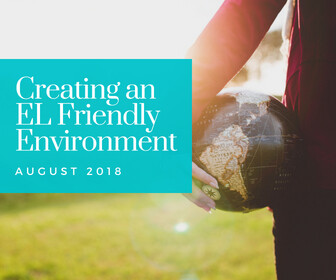To provide the best learning opportunities for English Language Learnings, we must start by understanding where ELs appear on the continuum of English language learning. If students are at a Preproduction stage (recently arrived), for example, they may not say anything for the first 0-6 months. This is not abnormal.
I once had a high school teacher thank me for explaining the stages of second language acquisition. She went on to say, “I have a sophomore in my language arts class who just recently arrived from Mexico and she hasn’t said a word to me. I thought it was because she didn’t like me.” This student was in the Preproduction stage which is also known as the “silent stage.”
Another young man from Asia who came to the U.S. when he was a freshman in high school, shared, “I stayed below the radar my whole four years. Teachers never asked me any questions because they figured I didn’t know any English.” Again, knowing the stages of second language acquisition is critical for developing a friendly environment for students so we as teachers are not expecting too little or too much from these students. For example, in a social studies unit on water conservation, a teacher wouldn’t expect a Preproduction or Early Production student to write an essay about water waste entirely in English. Students at a Preproduction stage could instead be asked to take photographs that illustrate water waste (such as someone brushing teeth with water running or watering their lawn during the hottest part of the day).
Creating an Environment Where Everyone Feels Welcome and Has an Equal Opportunity to Learn:
In our urgency to get ELLs to read and write, we’ve accidentally let student listening and speaking fall through the cracks. Opportunities for learning are created when students are in small groups so they can talk about what they are going to read, talk about what they’ve read, and talk about what they are going to write. Small groups are safe environments for them to try out new ideas, to hear how they sound when verbalized, and to hear others’ ideas. Small groups are safe havens for asking questions to further understanding or to hear another student’s description after a teacher’s explanation.
A classroom that has set the environment for students learning with each other has structures in place for productive accountable talk. For example, a real teacher favorite is Kagan’s Numbered Heads Together. Here’s how it works. The teacher has helped students to acquire and integrate knowledge on a topic; e.g. Ancient Civilizations. Now the teacher is ready to have all students practice, review, and apply what they’ve been learning. Class is divided into groups of four and each student seated at the four-top has a number from 1-4. Next, an open-ended prompt is given: How are Mayans and Egyptians the same or different? Everyone in the group of four contributes ideas and they must reach a consensus on only one similarity or difference to share out with the whole class. Everyone practices the similarity or difference because students do now know who in their group will report out. Finally, the teacher calls out a number from 1-4 and the student from each group with that number stands and reports their groups’ idea.
Every student has been included in a group. Every student has a sheltered environment (a group of four) to express an idea. Every student has an answer if called upon.
How to Best Teach ELs Across Content Areas:
Tip: Think about what you would want for your child if you and your family moved to France and your child was attending French-speaking schools. You would want your child’s teacher to make the content understandable in French by:
- adding pictures, real objects, and graphic organizers to accompany any information presented verbally;
- speaking slower with shorter sentences using high-frequency vocabulary;
- initially asking questions requiring a pointing or head-nod response from the student.
Since ELs perform double duty by mastering English language proficiency standards in addition to content standards, teachers with ELs are also doing double duty in teaching the two sets of standards. Rather than thinking of the two sets of standards as existing in silos and being taught as two separate entities, let’s think about how to link the two sets of standards. So, what is the bridge between content standards and English language proficiency standards? Academic language is the connection. That means classrooms are no longer sit-and-get settings but rather environs where students talk with each other and “sound like a book” about what they are learning, what they are reading and what they are going to write.
By paying attention to where students are on their continuum of English language acquisition and by providing numerous opportunities for ELs to hear and use the English they are in the process of learning will set you on the right course for moving your ELs towards success.
For more on the stages of second language acquisition see this five-minute video:
For more ideas on structures for academic talk as a way to establish a welcoming culture for talk and learning, see: English Language Learner Resource Guide: Top Ten Instructional Tips for Schools With a Low Incidence of ELLs
For more ideas on addressing beginning level second language learners see: Engaging Your Beginners.
For ideas on making this happen at a secondary level see Hill, J.D., & Hoak, H.K. (2015, February).
Jane Hill, M.S., a managing consultant at McREL, consults and trains teachers and administrators nationally and internationally. Her most recent endeavors involve demonstrating how strategies for ALL™ students (Academic Language Learners) and ELLs overlap in the classroom and what it takes to teach content through academic language and vice versa. Prior to joining McREL, Ms. Hill worked as a speech/language specialist focusing on bilingual special education, directed a two-way language school, and served as a district office director for second language acquisition and special education. She has worked in the areas of second language acquisition and special education for 37 years. In addition, Jane co-authored Classroom Instruction that Works (CITW) with ELLs (ASCD, 2006), CITW with ELLs Facilitator’s Guide and Participant’s Workbook (ASCD, 2008), CITW with ELLs, 2nd Edition (ASCD, 2013), and two instructional guides for schools with low-incidence ELLs.








